Numerical Simulation of a Simplified Reaction Model for the Growth of Graphene via Chemical Vapor Deposition in Vertical Rotating Disk Reactor
Abstract
:1. Introduction
2. Reaction Model and Numerical Calculation Method
2.1. Reactor Geometric Model and Grid Division
2.2. Chemical Reaction Model
2.3. Governing Equation of Rotational CVD Reaction Model
- (1)
- Radial momentum equation:
- (2)
- Axial momentum equation:
- (3)
- Energy equation:
- (4)
- The transport equation components:
2.4. Boundary Conditions and Parameter Settings
3. Simulation Results and Analysis
3.1. Influence of Temperature on Graphene Deposition Rate

3.2. Influence of Intake Flow Rate on Graphene Deposition Rate
3.3. Influence of Substrate Rotation Speed on Graphene Deposition Rate
3.4. Effects of Material Ratio on Graphene Deposition Rate
4. Effect of Carbon Surface Deposition Rate on the Growth Behavior of Graphene
4.1. Establishment of Simulation System
4.2. Selection of Simulation Potential Function
4.3. Influence of Carbon Surface Deposition Rate
5. Conclusions
Author Contributions
Funding
Institutional Review Board Statement
Informed Consent Statement
Data Availability Statement
Conflicts of Interest
References
- Novoselov, K.S.; Geim, A.K.; Morozov, S.V.; Jiang, D.E.; Zhang, Y.; Dubonos, S.V.; Grigorieva, I.V.; Firsov, A.A. Electric field effect in atomically thin carbon films. J. Sci. 2004, 306, 666–669. [Google Scholar] [CrossRef] [PubMed] [Green Version]
- Marcano Daniela, C.; Kosynkin, D.V.; Berlin, J.M.; Sinitskii, A.; Sun, Z.; Slesarev, A.; Alemany, L.B.; Lu, W.; Tour, J.M. Improved synthesis of graphene oxide. J. ACS Nano 2010, 4, 4806–4814. [Google Scholar] [CrossRef] [PubMed]
- Tromp, R.M.; Hannon, J.B. Thermodynamics and Kinetics of Graphene Growth on SiC(0001). J. Phys. Rev. Lett. 2009, 102, 106104. [Google Scholar] [CrossRef] [PubMed]
- Yoo, M.S.; Lee, H.C.; Lee, S.; Lee, S.B.; Lee, N.S.; Cho, K. Chemical Vapor Deposition of Bernal-Stacked Graphene on a Cu Surface by Breaking the Carbon Solubility Symmetry in Cu Foils. J. Adv. Mater. 2017, 29, 1700753.1–1700753.8. [Google Scholar] [CrossRef]
- Gao, Z.; Zhang, Q.; Naylor, C.H.; Kim, Y.; Abidi, I.H.; Ping, J.; Ducos, P.; Zauberman, J.; Zhao, M.Q.; Rappe, A.M.; et al. Crystalline Bilayer Graphene with Preferential Stacking from Ni–Cu Gradient Alloy. J. ACS Nano 2018, 12, 2275–2282. [Google Scholar] [CrossRef]
- Liu, N.; Fu, L.; Dai, B.; Yan, K.; Liu, X.; Zhao, R.; Zhang, Y.; Liu, Z. Universal Segregation Growth Approach to Wafer-Size Graphene from Non-Noble Metals. J. Nano Lett. 2011, 11, 297–303. [Google Scholar] [CrossRef]
- Cai, J.; Ruffieux, P.; Jaafar, R.; Bieri, M.; Braun, T.; Blankenburg, S.; Muoth, M.; Seitsonen, A.P.; Saleh, M.; Feng, X.; et al. Atomically precise bottom-up fabrication of graphene nanoribbons. J. Nat. 2010, 466, 470–473. [Google Scholar] [CrossRef]
- Giovanni, C.; Letizia, S.; Luca, V. Influence of Defects and Heteroatoms on the Chemical Properties of Supported Graphene Layers. Coatings 2022, 12, 397. [Google Scholar]
- Li, G.; Huang, S.-H.; Li, Z. Gas-phase dynamics in graphene growth by chemical vapour deposition. Phys. Chem. Chem. Phys. 2015, 17, 22832–22836. [Google Scholar] [CrossRef]
- Habuka, H.; Suzuki, J.; Takai, Y.; Hirata, H.; Mitani, S.-I. Silicon epitaxial growth process using trichlorosilane gas in a single-wafer high-speed substrate rotation reactor. J. Cryst. Growth 2011, 327, 1–5. [Google Scholar] [CrossRef]
- Mitrovic, B.; Parekh, A.; Ramer, J.; Merai, V.; Armour, E.A.; Kadinski, L.; Gurary, A. Reactor design optimization based on 3D modeling of nitrides deposition in MOCVD vertical rotating disc reactors. J. Cryst. Growth 2006, 289, 708–714. [Google Scholar] [CrossRef]
- Mitrovic, B.; Gurary, A.; Quinn, W. Process conditions optimization for the maximum deposition rate and uniformity in vertical rotating disc MOCVD reactors based on CFD modeling. J. Cryst. Growth 2007, 303, 323–329. [Google Scholar] [CrossRef]
- Kadinski, L.; Merai, V.; Parekh, A.; Ramer, J.; Armour, E.A.; Stall, R.; Gurary, A.; Galyukov, A.; Makarov, Y. Computational analysis of GaN/InGaN deposition in MOCVD vertical rotating disk reactors. J. Cryst. Growth 2004, 261, 175–181. [Google Scholar] [CrossRef]
- Habuka, H.; Tsuji, M. Silicon Epitaxial Growth Rate and Transport Phenomena in a Vertical Stacked-Type Multi-Wafer Reactor. Jpn. J. Appl. Phys. 2012, 51, 6701. [Google Scholar] [CrossRef]
- Makino, S.; Inagaki, M.; Nakagawa, M. Laminar-Turbulence Transition over the Rotor Disk in an Enclosed Rotor-Stator Cavity. Flow Turbul. Combust. 2015, 95, 399–413. [Google Scholar] [CrossRef]
- Santen, H.V.; Kleijn, C.R.; Van den Akker, H.E.A. Computational Technologies for Fluid/Thermal Structure/Chemical Systems with Industrial Applications; Kudriavtsev, V.V., Cheng, W., Kleijn, C.R., Wano, S., Souli, M., Eds.; ASME International: New York, NY, USA, 1989; p. 211. [Google Scholar]
- Evans, G.; Greif, R. Forced flow near a heated rotating disk: A similarity solution. Numer. Heat Transf. 1988, 14, 373. [Google Scholar] [CrossRef]
- Mazaev, K.M.; Lobanova, A.V.; Yakovlev, E.V.; Talalaec, R.A.; Galyukov, A.O.; Makarov, Y.N.; Gotthold, D.; Albert, B.; Kadinski, L.; Peres, B. Modeling and experimental analysis of AlGaN MOVPE in commercial vertical high-speed rotating-disk reactors. J. Cryst. Growth 2004, 261, 190–196. [Google Scholar] [CrossRef]
- Lobanova, A.; Mazaev, K.; Yakoviev, E.; Talalaev, R.; Galyukov, A.; Gotthold, Y.M.D.; Albert, B.; Kadinski, L.; Peres, B. Parametric studies of III-nitride MOVPE in commercial vertical high-speed rotating disk reactors. J. Cryst. Growth 2004, 266, 354–362. [Google Scholar] [CrossRef]
- Kataoka, T.; Sato, Y.; Ohmine, T. Chemical Vapor Deposition: Proceedings of the Fourteenth International Conference and EUROCVD-11. 1997, p. 1319. Available online: https://searchworks.stanford.edu/view/3769748 (accessed on 27 June 2023).
- Sato, Y.; Ohmine, T. Extended Abstracts of the 1991 International Conference on Solid State Devices and Materials. 1991, p. 717. Available online: https://confit.atlas.jp/guide/organizer/ssdm/ssdm1991/top?initFlg=true (accessed on 27 June 2023).
- Kremer, D.M.; Davis, R.W.; Moore, E.F.; Maslar, J.E.; Burgess, D.; Ehrman, S.H. An Investigation of Particle Dynamics in a Rotating Disk Chemical Vapor Deposition Reactor. J. Electrochem. Soc. 2003, 150, G127–G139. [Google Scholar] [CrossRef]
- ANSYS, Inc. ANSYSFluentTheory Guide; ANSYS, Inc.: Canonsburg, PA, USA, 2021; pp. 235–237. [Google Scholar]
- Coltrin, M.E.; Kee, R.J.; Evans, G.H. A Mathematical Model of the Fluid Mechanics and Gas-Phase Chemistry in a Rotating Disk Chemical Vapor Deposition Reactor. J. Electrochem. Soc. 1989, 136, 819–829. [Google Scholar] [CrossRef]
- Fan, Y.W. Silane pyrolysis vapor deposition reaction model and numerical simulation of fluidized bed CVD reactor. East China Univ. Sci. Technol. 2017, 28–29. (In Chinese) [Google Scholar]
- Wauters, S.; Marin, G.B. Kinetic Modeling of Coke Formation during Steam Cracking. Ind. Eng. Chem. Res. 2002, 41, 2379–2391. [Google Scholar] [CrossRef]
- Becker, A.; Hüttinger, K. Chemistry and kinetics of chemical vapor deposition of pyrocarbon—IV pyrocarbon deposition from methane in the low temperature regime. Carbon 1998, 36, 213–224. [Google Scholar] [CrossRef]
- Tao, H.; Chen, H.; Xie, J.; Shu, Z.; Hu, Y.; Lu, H. Fluid Flow Uniformity Index Based on area weighted average velocity and mass Weighted average Velocity. J. Chem. Eng. 2010, 61, 116–120. [Google Scholar]
- Brüggert, M.; Hu, Z.; Hüttinger, K.J. Chemistry and kinetics of chemical vapor deposition of pyrocarbon—VI. influence of temperature using methane as a carbon source. Carbon 1999, 37, 2021–2030. [Google Scholar] [CrossRef]
- Hu, Z.; Hüttinger, K.J. Chemistry and kinetics of chemical vapor deposition of pyrocarbon: VIII. Carbon deposition from methane at low pressures. Carbon 2001, 39, 433–441. [Google Scholar] [CrossRef]
- Vlassiouk, I.; Regmi, M.; Fulvio, P.; Dai, S.; Datskos, P.; Eres, G.; Smirnov, S. Role of hydrogen in chemical vapor deposition growth of large single-crystal graphene. ACS Nano 2011, 5, 6069–6076. [Google Scholar] [CrossRef]
- Zou, Z.; Dai, B.; Liu, Z. Growth and process engineering of graphene by chemical vapor deposition. Sci. China Chem. 2013, 17. (In Chinese) [Google Scholar]
- Zi, J.H.; Hüttinger, K.J. Mechanisms of carbon deposition—A kinetic approach. Carbon 2002, 40, 624–628. [Google Scholar]
- Chen, Q.; Song, Q.; Yi, X.; Chen, Q.; Wu, W.; Huang, M.; Zhao, C.; Wang, S.; Zhu, H. Growth of high quality bilayer graphene on softened copper foils by atmospheric chemical vapor deposition. Sci. China Mater. 2020, 63, 1973–1982. [Google Scholar] [CrossRef]
- Bai, Q.; Dou, Y.; He, X.; Zhang, A.; Guo, Y. Deposition and growth mechanism of graphene on copper crystal surface based on molecular dynamics simulation. Acta Phys. Sin. 2020, 69, 348–356. (In Chinese) [Google Scholar] [CrossRef]
- Poorsargol, Z. The role of hydroxyl and carboxyl functional groups in adsorption of copper by carbon nanotube and hybrid graphene-carbon nanotube: Insights from molecular dynamic simulation. Adsorption 2020, 26, 397–405. [Google Scholar] [CrossRef]
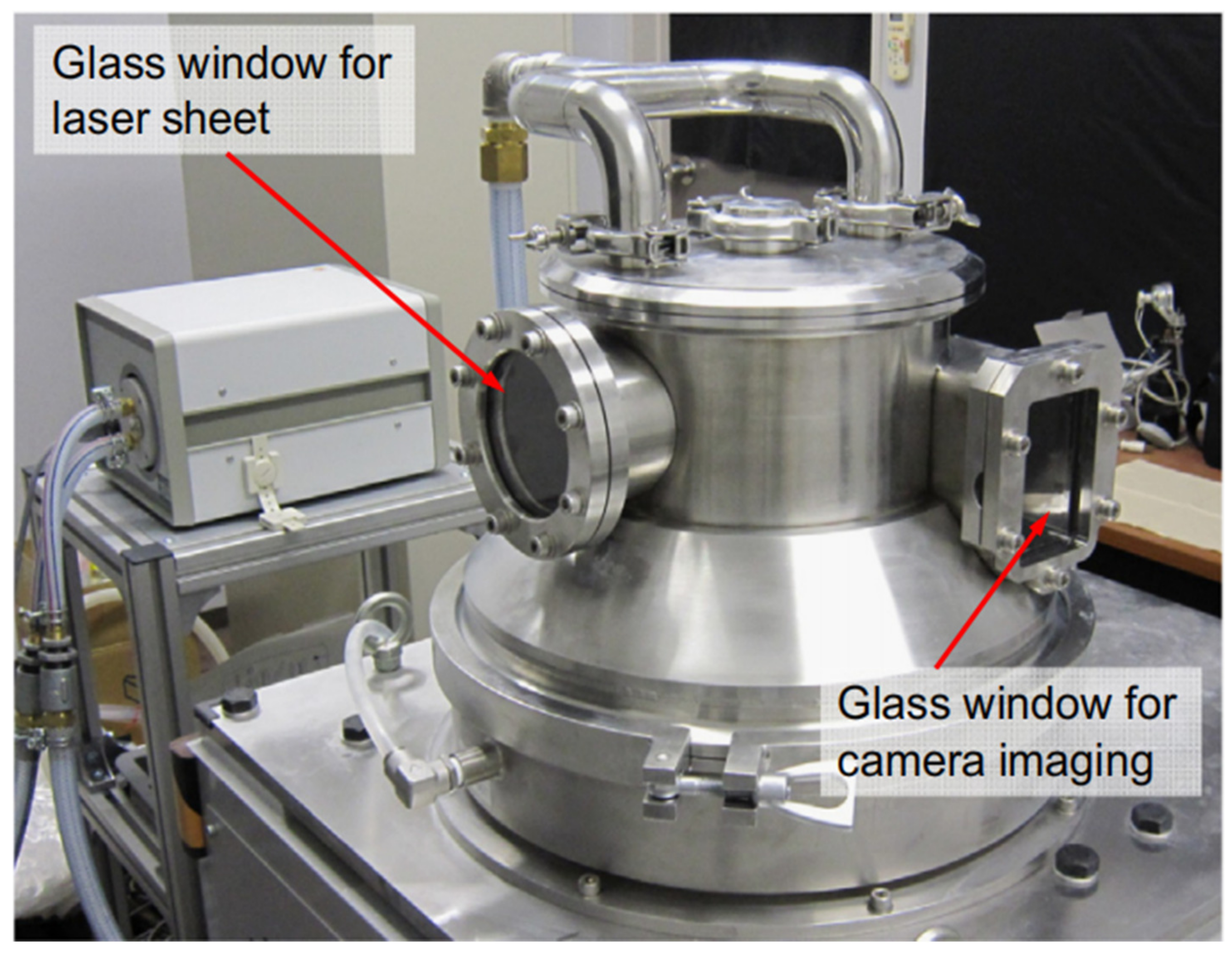
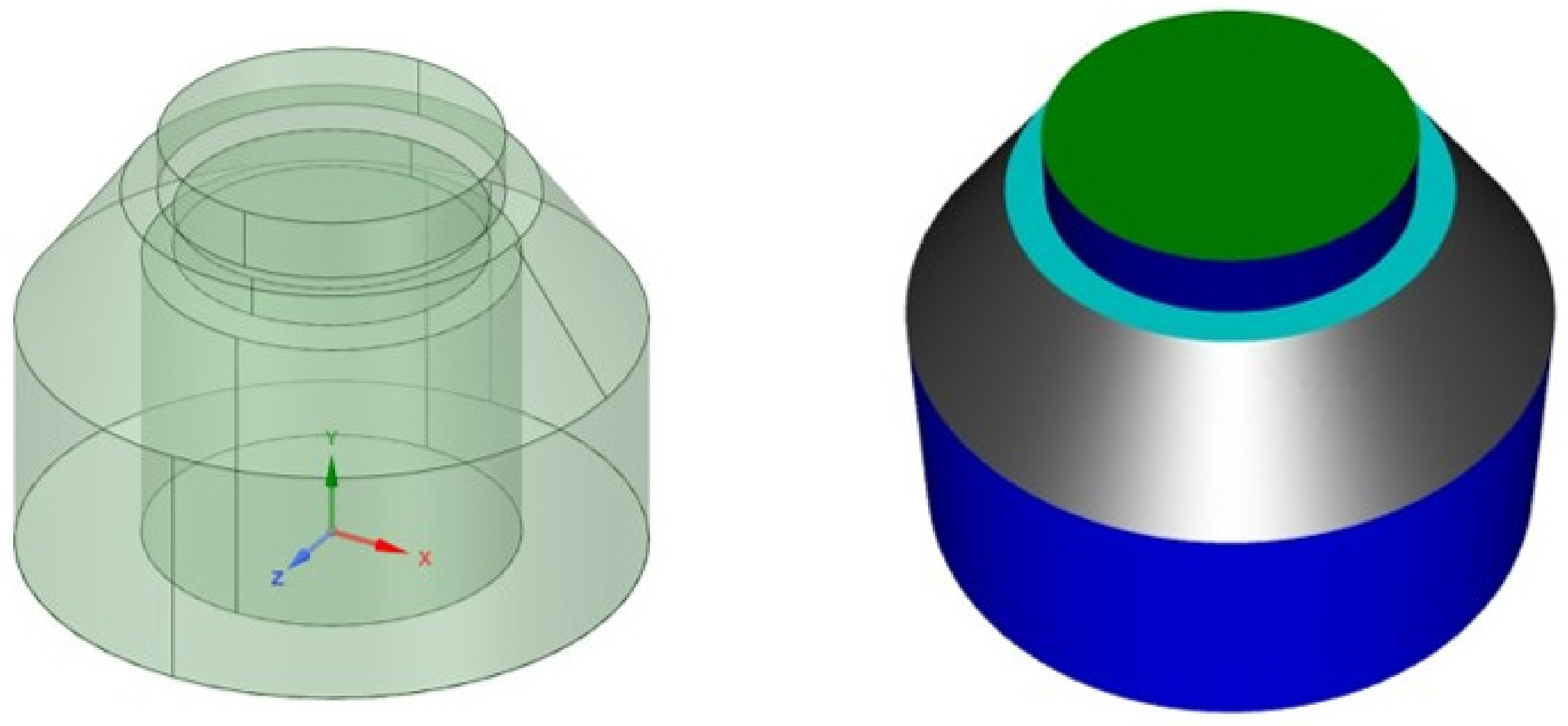

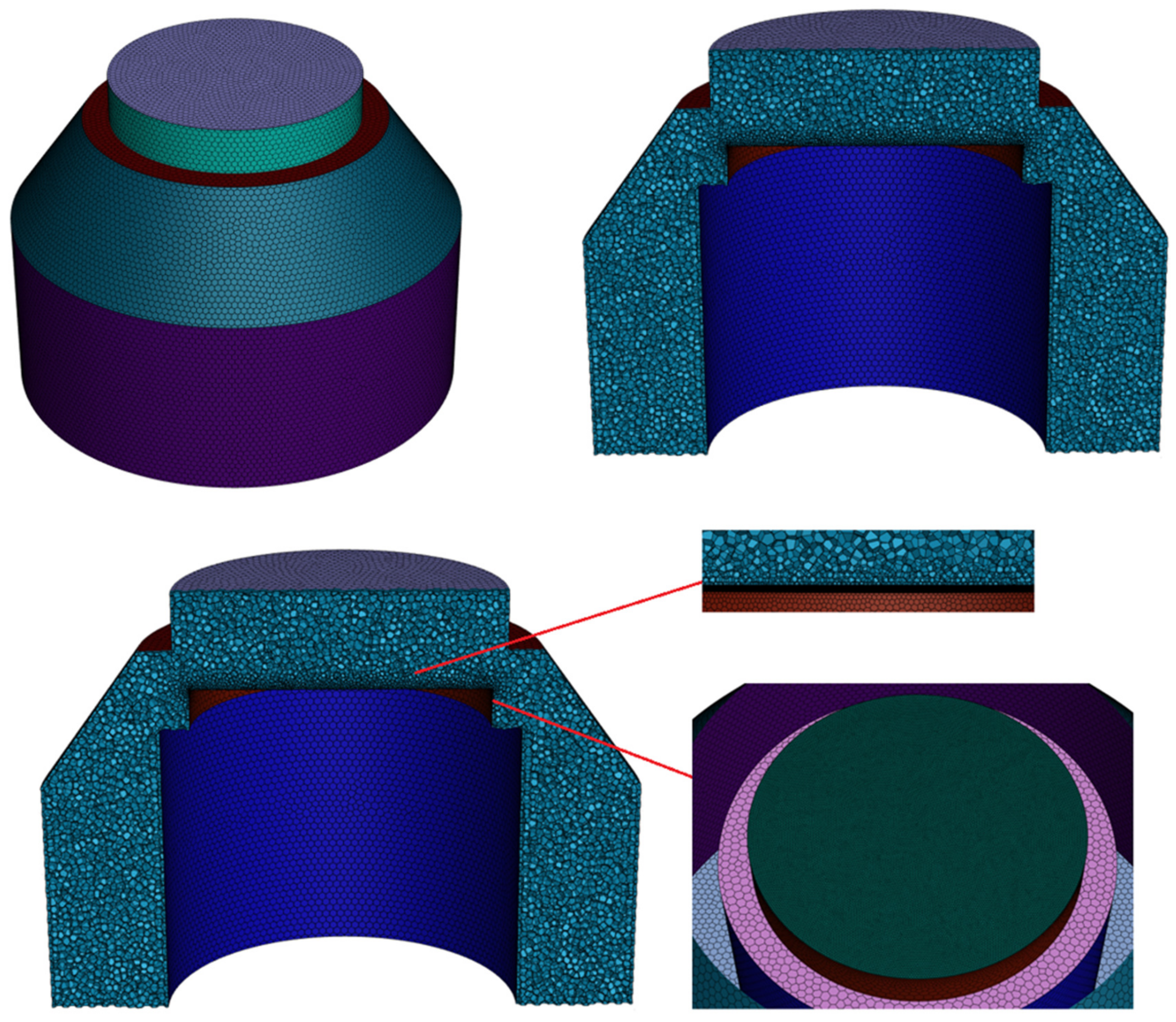
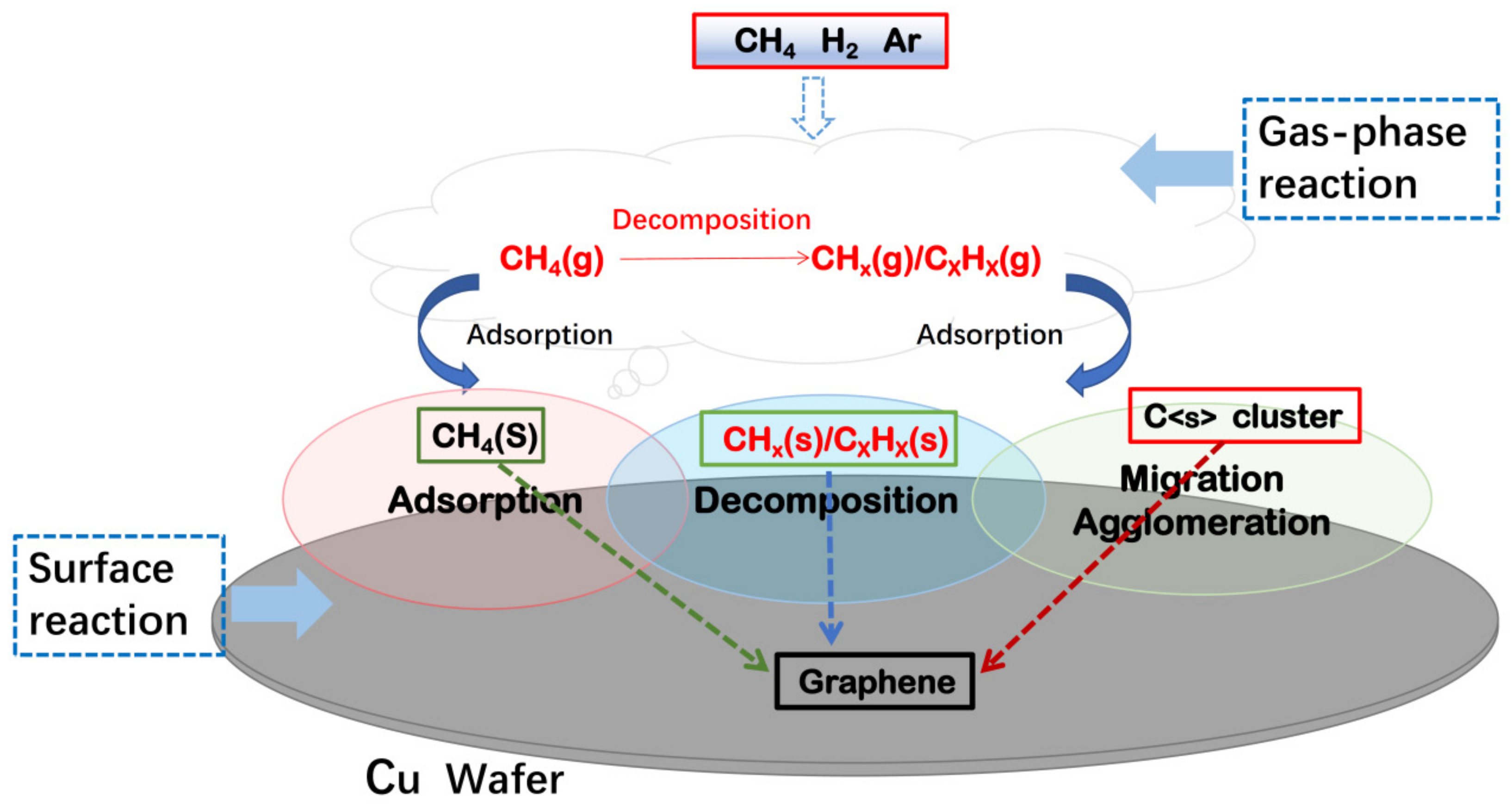
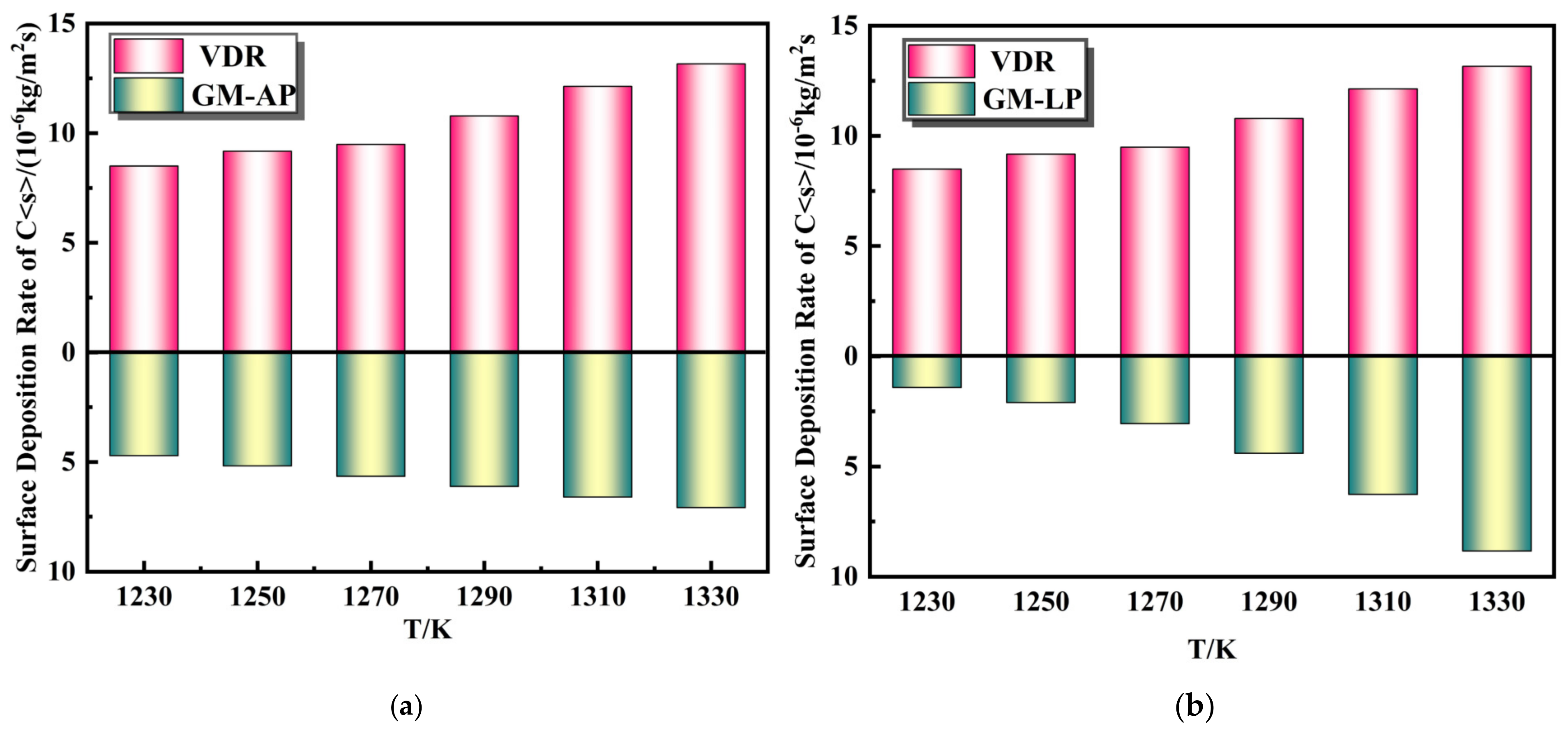
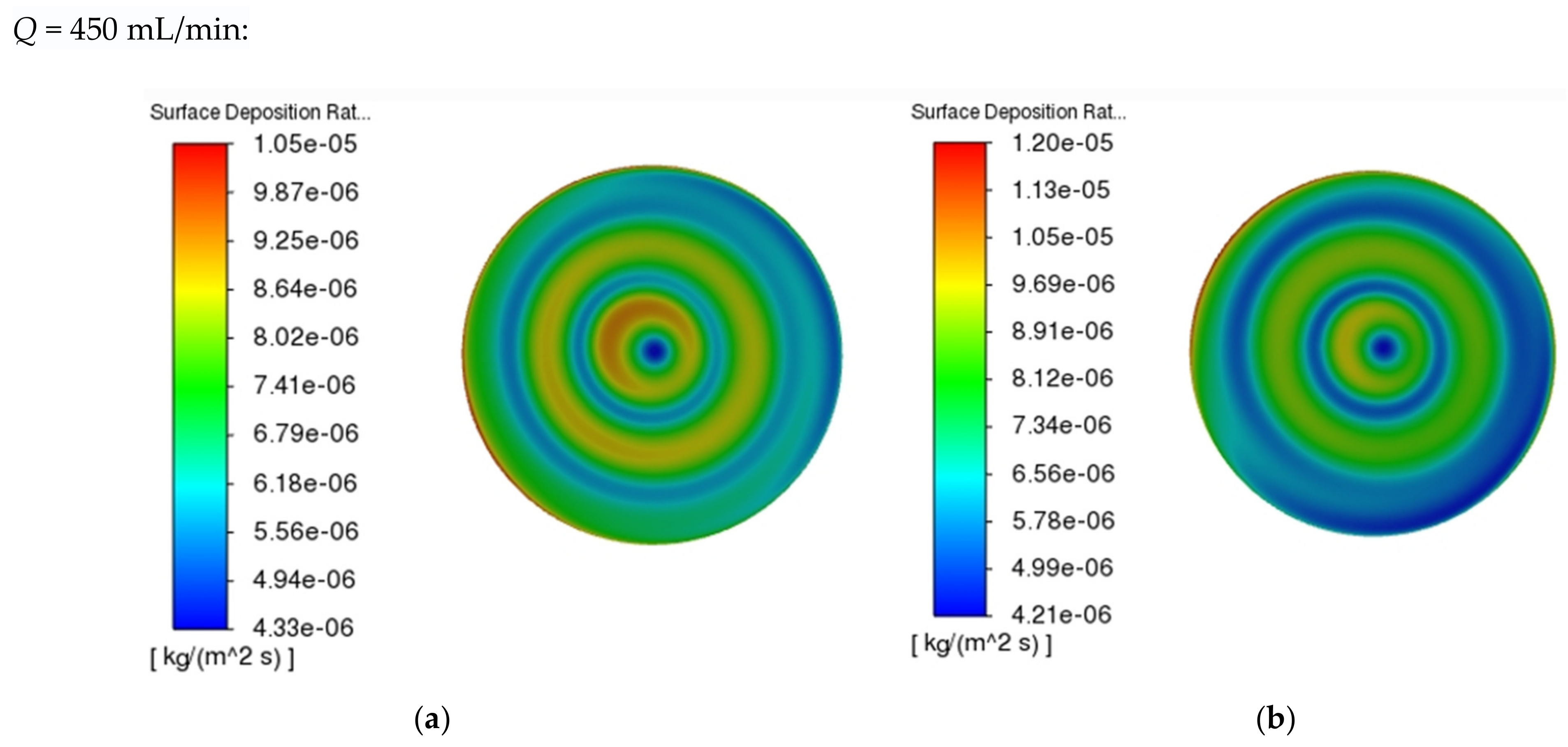

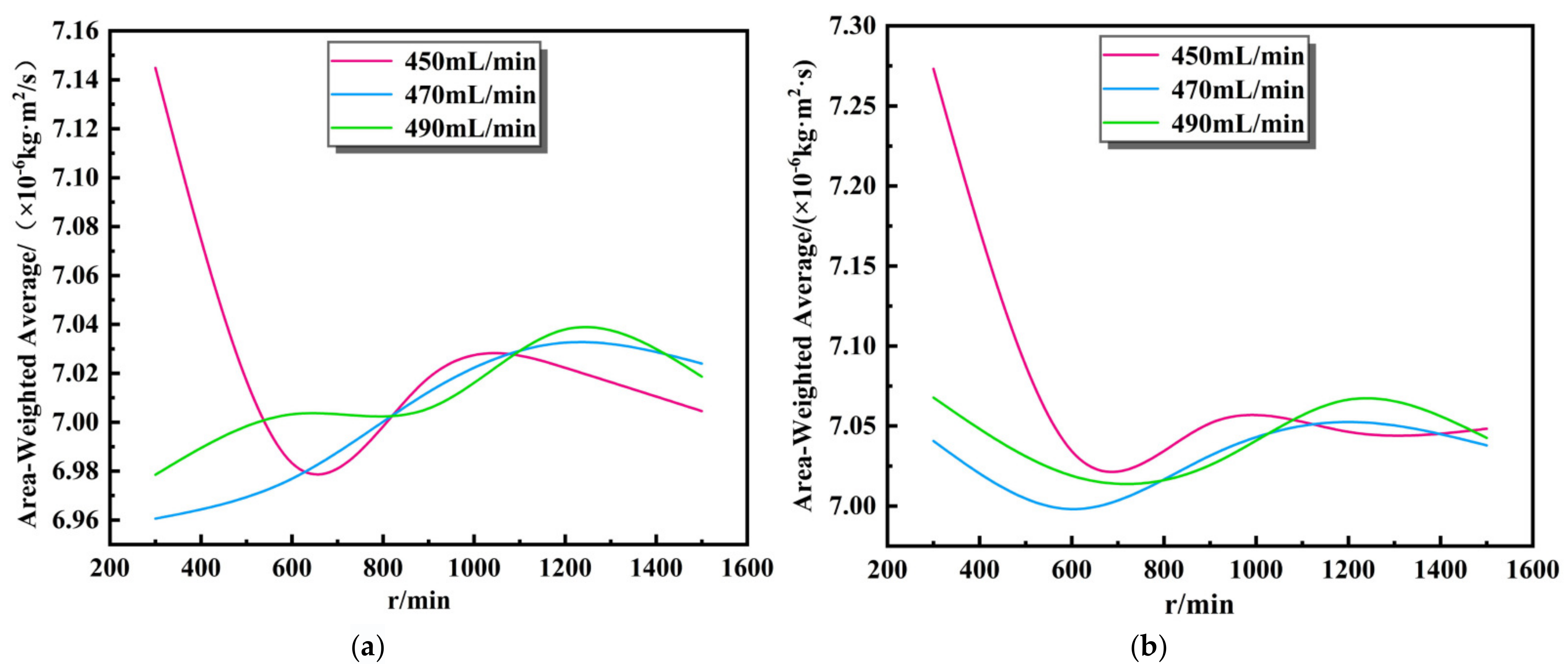
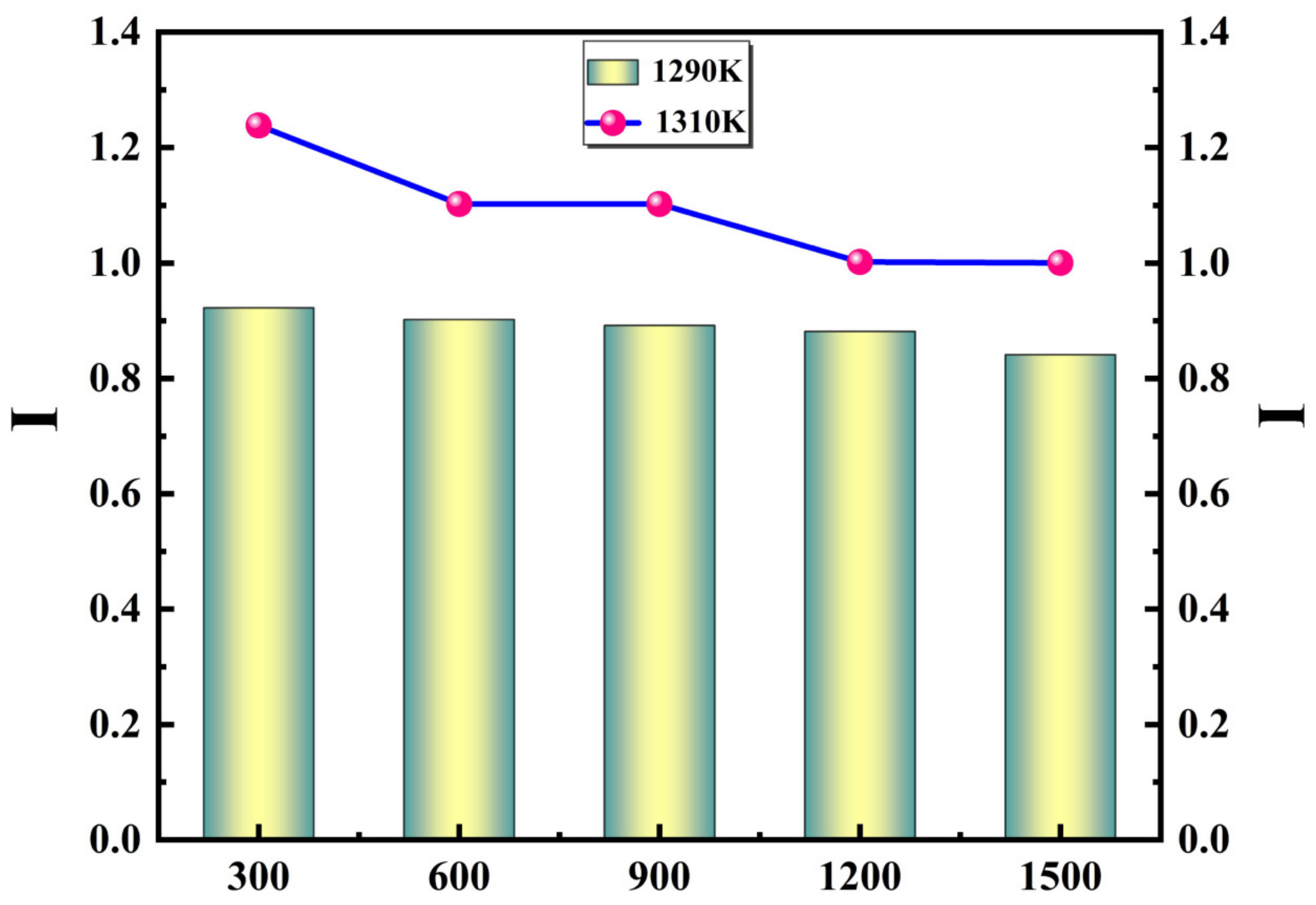

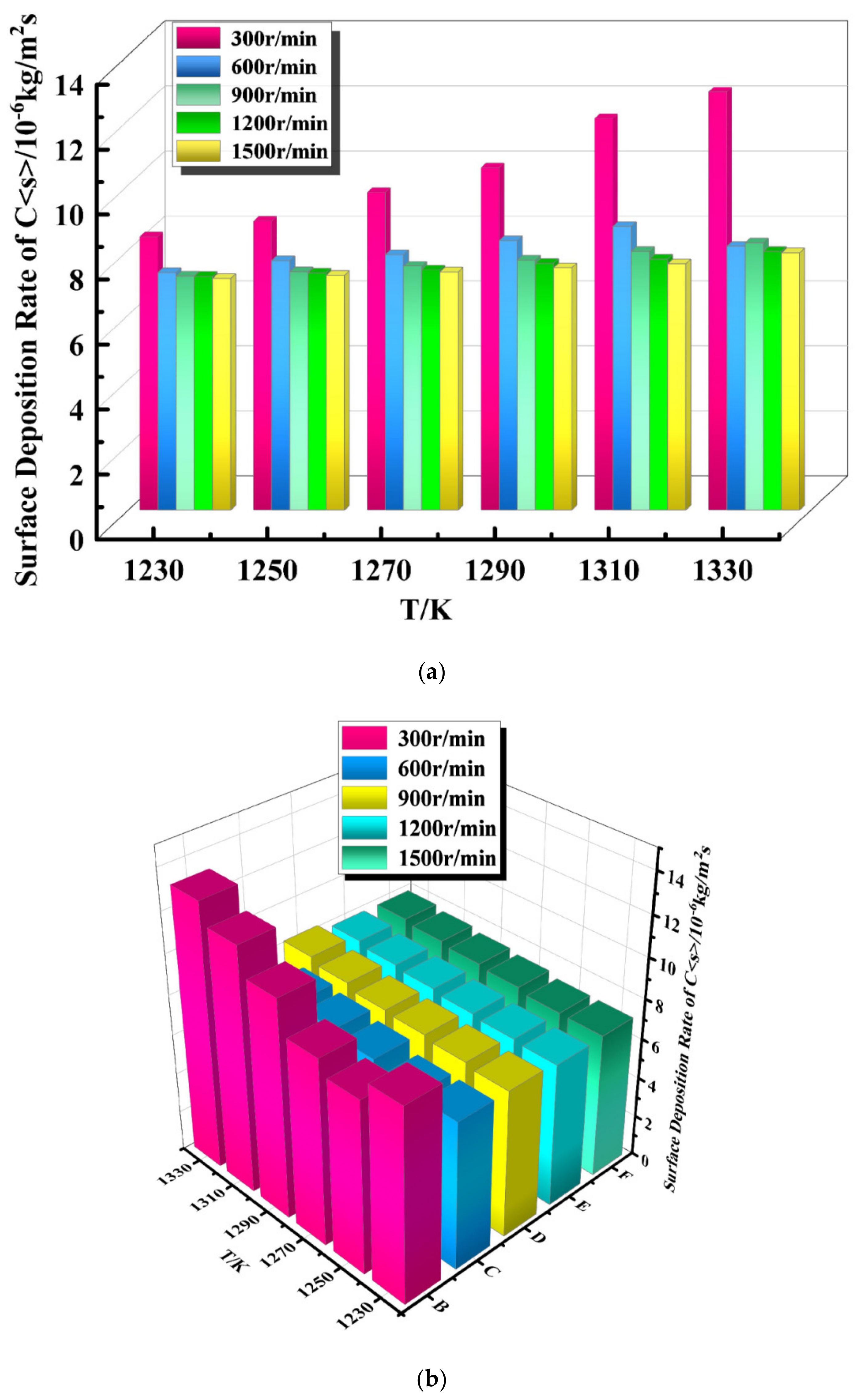
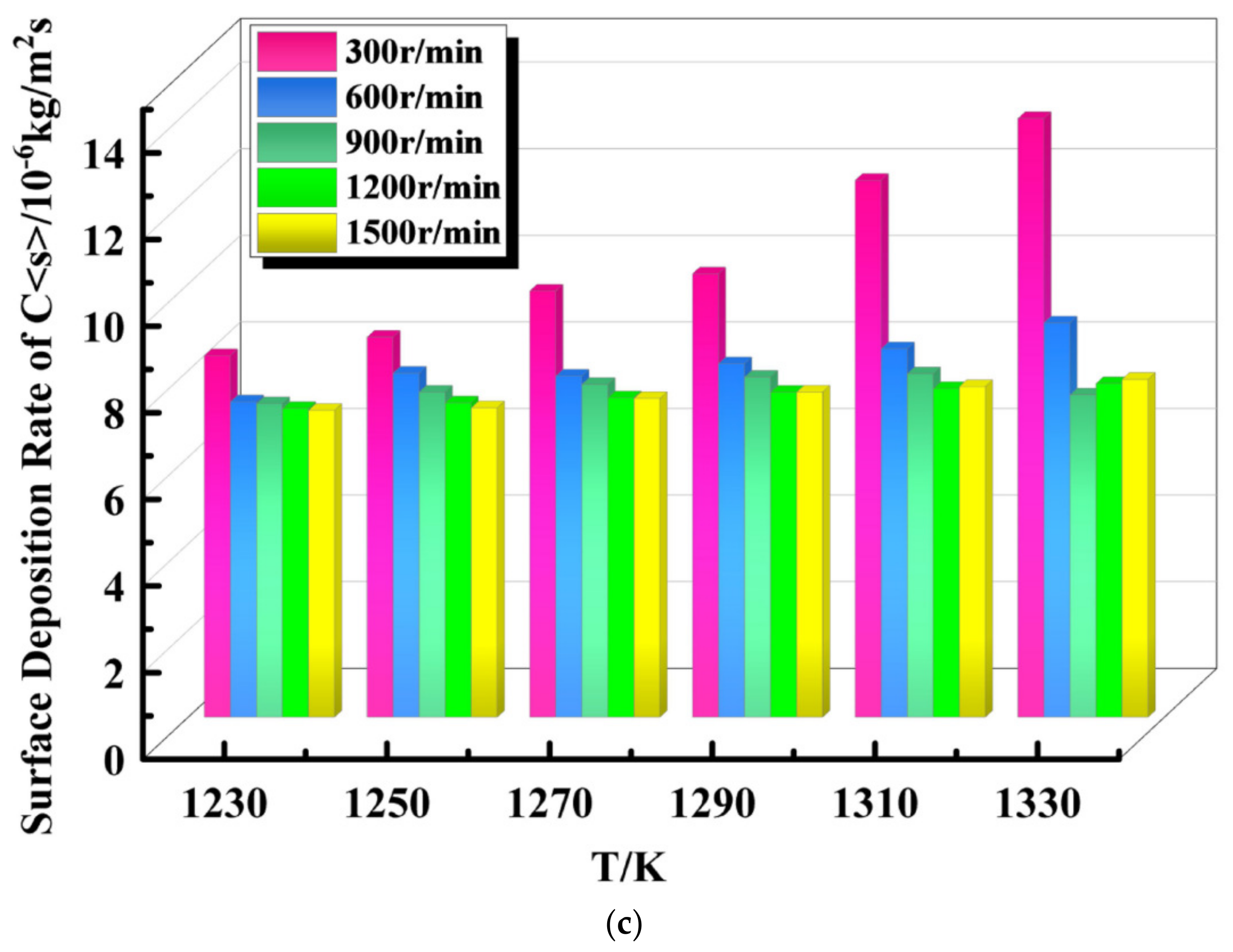


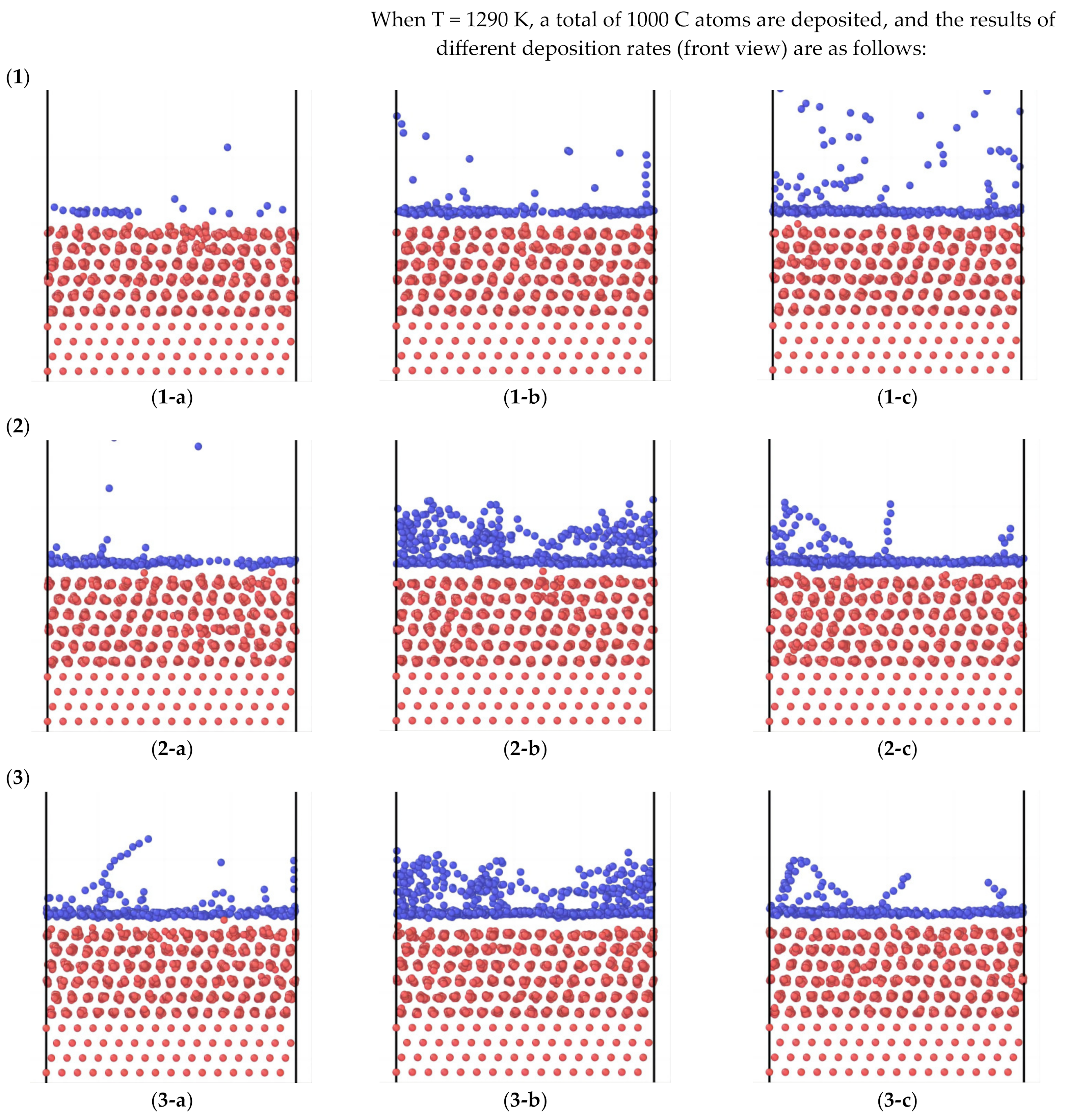
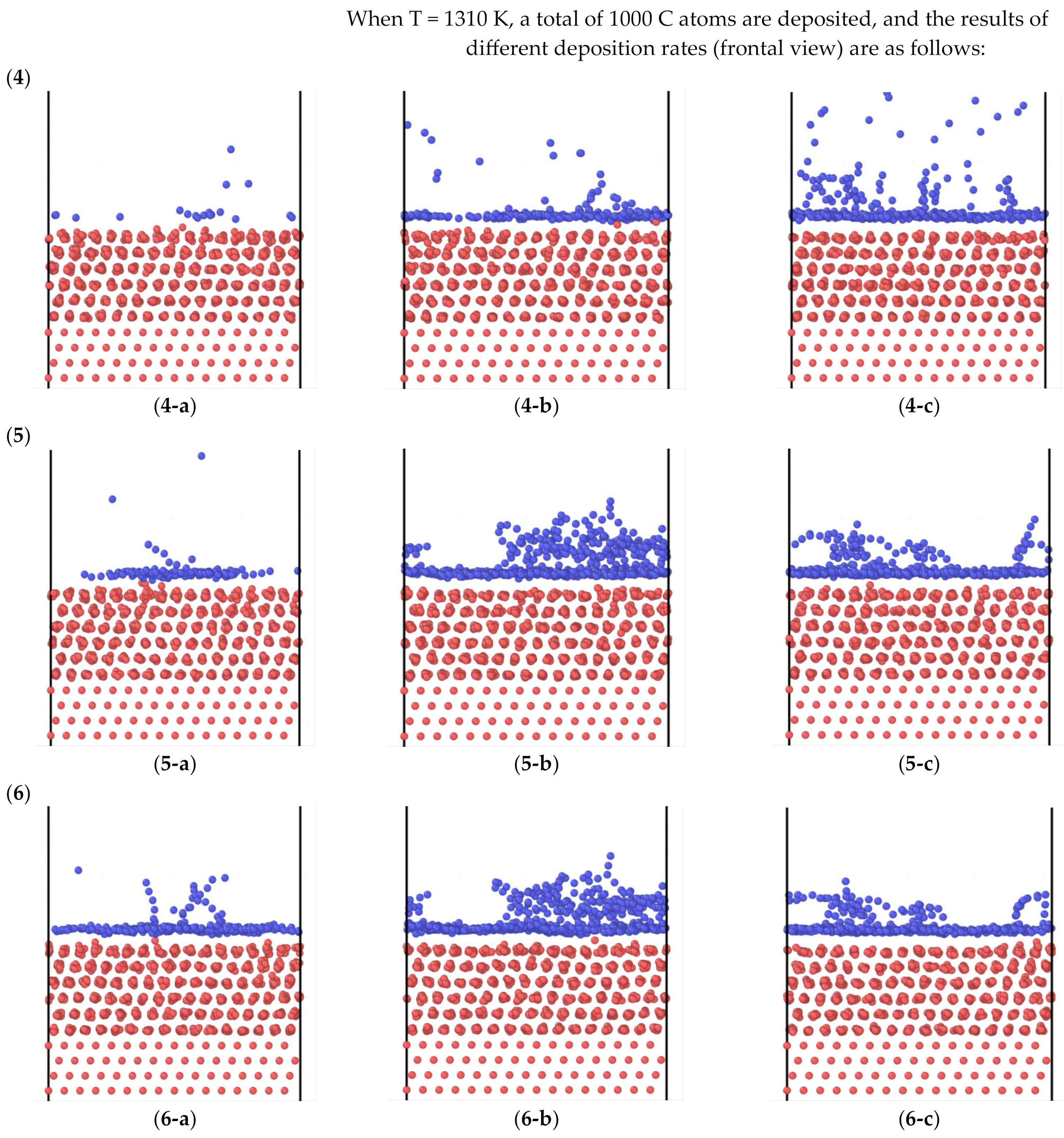
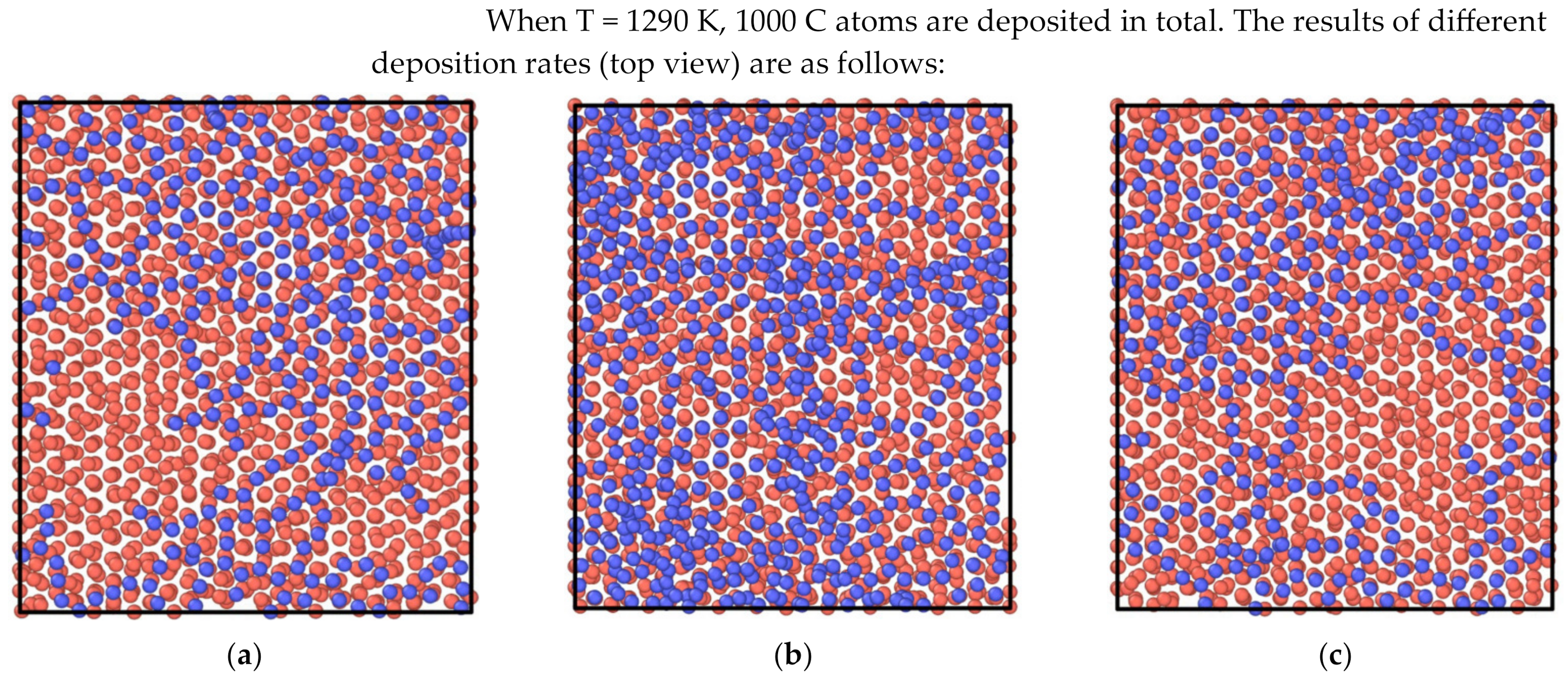

| Physical Parameter | CH4 | H2 | Ar | C <S> |
|---|---|---|---|---|
| Density (kg/m3) | 0.6679 | 0.08189 | 1.6228 | 2000 |
| Cp (j/kg·k) | 2222 | 14,283 | 520.64 | 1220 |
| Thermal conductance (w/m·k) | 0.0332 | 0.1672 | 0.0158 | |
| Viscosity (kg/m·s) | 1.087 × 10−5 | 8.411 × 10−6 | 2.215 × 10−5 | |
| △Hm (j/kmol) | −7.489518 × 107 | 0 | −3117.71 | −101.268 |
| △Sm (j/kmol·k) | 186,040.1 | 130,579.1 | 154,719.3 | 5731.747 |
Disclaimer/Publisher’s Note: The statements, opinions and data contained in all publications are solely those of the individual author(s) and contributor(s) and not of MDPI and/or the editor(s). MDPI and/or the editor(s) disclaim responsibility for any injury to people or property resulting from any ideas, methods, instructions or products referred to in the content. |
© 2023 by the authors. Licensee MDPI, Basel, Switzerland. This article is an open access article distributed under the terms and conditions of the Creative Commons Attribution (CC BY) license (https://creativecommons.org/licenses/by/4.0/).
Share and Cite
Yang, B.; Yang, N.; Zhao, D.; Chen, F.; Yuan, X.; Hou, Y.; Xie, G. Numerical Simulation of a Simplified Reaction Model for the Growth of Graphene via Chemical Vapor Deposition in Vertical Rotating Disk Reactor. Coatings 2023, 13, 1184. https://doi.org/10.3390/coatings13071184
Yang B, Yang N, Zhao D, Chen F, Yuan X, Hou Y, Xie G. Numerical Simulation of a Simplified Reaction Model for the Growth of Graphene via Chemical Vapor Deposition in Vertical Rotating Disk Reactor. Coatings. 2023; 13(7):1184. https://doi.org/10.3390/coatings13071184
Chicago/Turabian StyleYang, Bo, Ni Yang, Dan Zhao, Fengyang Chen, Xingping Yuan, Yanqing Hou, and Gang Xie. 2023. "Numerical Simulation of a Simplified Reaction Model for the Growth of Graphene via Chemical Vapor Deposition in Vertical Rotating Disk Reactor" Coatings 13, no. 7: 1184. https://doi.org/10.3390/coatings13071184




